WCF Overview
1.
What Is WCF?
WCF stands for Windows Communication
Foundations.
WCF combines the functionality from ASP.NET Web
Services, .NET Remoting, Message Queuing and Enterprise Services.
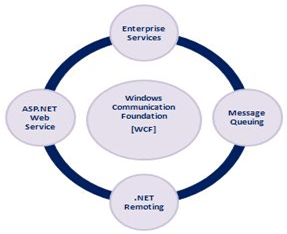
WCF provides the following
features,
-
Hosting For Component & Services
WCF
Service can be hosted in ASP.NET Runtime, a Windows Service, a COM+
Component or just a Windows form application for peer-to-peer computing.
-
Declarative Behavior
Similar to ASP.NET Web
Services, attributes can be used for WCF Services e.g.
ServiceContract(), OperationContract, DataContract and DataMember
-
Communication Channels
Similar to .NET
Remoting WCF Services are flexible in changing the channels. WCF offers
multiple channels to communicate using HTTP, TCP or an IPC channel.
-
Security
-
Extensibility
2. Understanding WCF-
These days we are
creating the software/application which should be capable of
communication with other applications as well. Communication with other
application simply means either sharing/exchanging the data or the
sharing the logic.
Now, this communication may be of two kinds
-
Over Intranet (Same Network/Platform i.e. .NET
Application to .NET Application)
-
Over Internet (Cross Platform may be ASP.NET to J2EE
Application)
Suppose we are writing a .NET Software with n-tier
architecture in which Win Form Client needs to communicate with Server
in the same network. In such case we may go for .NET Remoting for
communication between Client and Server.
Suppose, once our
software mentioned above is ready, we need to expose some business logic
to another J2EE application. This J2EE application is supposed to use
our .NET Application's logic over WWW. In such case we will have to
write new ASP.NET Web Service to expose the logic.
Picture shown
below shows the limitation of .NET Remoting

WCF helps us to overcome
this kind of Scenario, as WCF Service can be used as a .NET Remoting
Component and ASP.NET Web Services as well.

3. WCF in Real Time
Scenario
Suppose a 7 Star hotel has contacted you for
software which will help the organization to managing the hotel's room
booking say "Room Booking System
". Apart from its own features
software should be capable of
-
Communication with already running software within the
hotel's network for help desk purpose. (.NET Windows Form Application)
-
Communication with already running software on Tourism
Office for booking of rooms. (A J2EE Application supposed to access the
application over WWW)
Off course we are suppose to implement the application
using Microsoft.NET Technology.
Now, as we know that in order to
communicate with another .NET application within same network .NET
Remoting is the best option. But as per our requirement our application
should be capable of interaction with another J2EE application over WWW.
So we can't go for .NET Remoting. ASP.NET web services may work fine
but the correct option for now would be WCF Service.

4.
Difference between WCF and ASP.NET
Web Services
|
Windows
Communication Foundation (WCF)
|
ASP.NET Web
Service
|
|
WCF supports multiple
bindings HTTP, WSHTTP, TCP, MSMQ.
|
ASP.NET Web Services
supports only HTTP binding.
|
|
WCF supports Atomic
Transactions*.
|
ASP.NET Web Services
does not support Atomic Transactions*.
|
|
By default WCF uses
SOAP for sending and receiving the messages. But WCF can support any
kind of message format not only SOAP.
|
ASP.NET Web Services
can send and receive messages via the SOAP only.
|
|
The
System.Runtime.Serialization.DataContract and
System.Runtime.Serialization.DataMember attributes of the WCF's
System.Runtime.Serialization assembly can be added for .NET types to
indicate that instances of the type are to be serialized into XML, and
which particular fields or properties of the type are to be serialized.
|
ASP.NET
Web Services uses XmlSerializer to translate the XML data (Message Send
or received) into .NET objects.
|
Atomic Transactions
Following example describes that what does it
mean by Atomic Transactions
Consider that bank A and bank B want to
interact with someone's account at the same time. Both banks want to
withdraw from the account and the account has $10.00 in it. If bank A
takes $7.00 and at the same time bank B tries to get $5.00, what will
happen? When they start the transaction each bank believes there is
$10.00 available in the account. When one of them finishes the other one
will find there is not enough money to finish the transaction.
This scenario is common for computer systems
and you can see it many times in memory management, IO operations and
database interactions.
Atomic transactions are a way to avoid this
problem. They simply lock on a transaction and do not allow any other
transaction to interact with the resource. If anything fails during the
Atomic transaction, everything will return to the state before the
transaction started.
5. WCF Communication Model
WCF follows
Client-Server Architecture. Communication between Client and Server are
established with the help of Endpoints exposed by the WCF Service.
Endpoints are nothing but the locations defined by service through which
message can be sent and received. Service may have multiple end points.

6. Know some terms/ Kew
words
-
ServiceContract
Service contracts describe
the operations supported by a service, the message exchange pattern they
use, and the format of each message. The service contract may be an
interface or class for generating a service description. A service must
implement at least one service contract. Interface or class supposed to
be exposed as a service should be decorated with
ServiceContractAttribute
-
OperationContract
Methods in the interface
or class which are supposed to be exposed as a service should be
decorated with OperationContractAttribute.
-
DataContract
Data contracts describe how a
CLR type maps to schema. A data contract may be understood as a class or
interface which is mapped to database and are supposed to exploit by
WCF Service. This class or interface needs to be decorated with
DataContract attribute.
-
DataMember
Properties or database table
columns in the DataContract class which are supposed to be used by WCF
Service should be decorated with DataMember attribute.
7. WCF Binding Comparisons
As we discussed in point 4 that WCF supports multiple
bindings e.g. HTTP, TCP and etc. Following table describes about the
various bindings supported by WCF. Bindings are configurable and can be
achived by changing web.config file.
| Binding Class Name |
Transport |
Message Encoding |
Message Version |
Security Mode |
RM |
Tx Flow* |
| BasicHttpBinding |
HTTP |
Text |
SOAP 1.1 |
None |
X |
X |
| WSHttpBinding |
HTTP |
Text |
SOAP 1.2
WS-A 1.0 |
Message |
Disabled |
WS-AT |
| WSDualHttpBinding |
HTTP |
Text |
SOAP 1.2
WS-A 1.0 |
Message |
Enabled |
WS-AT |
| WSFederationHttpBinding |
HTTP |
Text |
SOAP 1.2
WS-A 1.0 |
Message |
Enabled |
WS-AT |
| NetTcpBinding |
TCP |
Binary |
SOAP 1.2 |
Transport |
Disabled |
Ole Tx |
| NetPeerTcpBinding |
P2P |
Binary |
SOAP 1.2 |
Transport |
X |
X |
| NetNamedPipesBinding |
Named Pipes |
Binary |
SOAP 1.2 |
Transport |
X |
Ole Tx |
| NetMsmqBinding |
MSMQ |
Binary |
SOAP 1.2 |
Message |
X |
X |
| MsmqIntegrationBinding |
MSMQ |
X** |
X |
Transport |
X |
X |
| CustomBinding |
You decide |
You decide |
You decide |
You decide |
You decide |
You decide |
Where,
- X = Not Supported
- X = Not Supported
- WS-A = WS-Addressing
- WS-AT = WS-AtomicTransaction
- OleTx = OleTransactions
- * Transaction flow is always disabled by default, but when you
enable it, these are the default tx protocols
- * This binding doesn't use a WCF message encoding – instead it
lets you choose a pre-WCF serialization format
8. How to Create a Sample WCF Application with VS2008?
8.1 Create/ Manage database
Before proceeding
toward the WCF Service Creation, we need to create a database say,
"WCF" with one table having following schema

Where, ReservationId is an
auto generated Primary Key column.
Note:
You may also
restore the backup of the database given along with the sample
application.
8.2 Create WCF Service
-
Open Visual Studio
-
Go to File -> New -> Project
-
From the left panel, select Web node of your language
VB.NET/C#.NET
-
Now among the templates you will see WCF Service
Application
-
Select the same (WCF Service Application)
-
Give Suitable Name (Say Practice.WCF) and Click on OK
button.
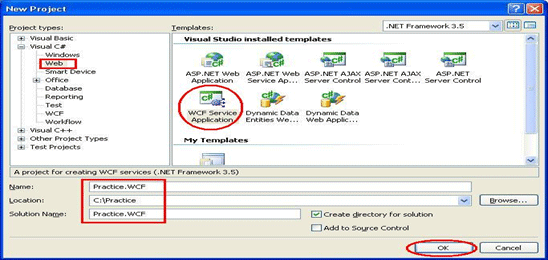
-
Modify the connection strings section of web.config
file of the WCF Service
<
connectionStrings
>
<
add
name
=
"con
"
connectionString
=
"Data
Source=PRODSK0542;Initial Catalog=WCF;User
Id=sa;Password=Swayam1;
"
providerName
=
"System.Data.SqlClient
"/>
</
connectionStrings
>
-
By default Visual Studio would create a Service and an
Interface Service1.svc and IService1.cs
-
Add new class RoomReservationRequest.cs (DataContract)
-
Import the name space System.Runtime.Serialization; if
not imported
-
Create property with same data type for each columns
present into the RoomReservationRequest table. Decorate
RoomReservationRequest.cs class with [DataContract] attribute and each
property with [DataMember].
namespace
Practice.WCF
{
[DataContract
]
public
class
RoomReservationRequest
{
[DataMember
]
public
int
ReservationId
{
get
; set
;
}
[DataMember
]
public
int
NoOfRooms
{
get
; set
;
}
[DataMember
]
public
string
TypeOfRoom
{
get
; set
;
}
[DataMember
]
public
DateTime
FromDate
{
get
; set
;
}
[DataMember
]
public
DateTime
ToDate
{
get
; set
;
}
[DataMember
]
public
string
ContactPersonName
{
get
; set
;
}
[DataMember
]
public
string
ContactPersonMail
{
get
; set
;
}
[DataMember
]
public
string
ContactPersonMob
{
get
; set
;
}
[DataMember
]
public
string
Comments
{
get
; set
;
}
[DataMember
]
public
string
Status
{
get
; set
;
}
}
}
-
Add a new class RoomReservationData.cs and write two
methods say ReserveRoom and GeReservations
namespace
Practice.WCF
{
internal
class
RoomReservationData
{
private
string
connectionString = ConfigurationManager
.ConnectionStrings["con"
].ConnectionString;
internal
bool
ReserveRoom(RoomReservationRequest
roomReservationReq)
{
SqlConnection
connection = GetConnection();
string
sqlCommand = "INSERT INTO
RoomReservationRequest(NoOfRooms, TypeOfRoom, FromDate, ToDate,
ContactPersonName, "
+
"ContactPersonMail, ContactPersonMob, Comments, Status)
VALUES ("
+
"@NoOfRooms,
@TypeOfRoom, @FromDate, @ToDate, @ContactPersonName, "
+
"@ContactPersonMail,
@ContactPersonMob, @Comments, @Status)"
;
SqlCommand
command =
connection.CreateCommand();
command.CommandText =
sqlCommand;
command.Parameters.Add("@NoOfRooms"
, System.Data.SqlDbType
.Int);
command.Parameters.Add("@TypeOfRoom"
,
System.Data.SqlDbType
.NVarChar,
20);
command.Parameters.Add("@FromDate"
, System.Data.SqlDbType
.DateTime );
command.Parameters.Add("@ToDate"
,
System.Data.SqlDbType
.DateTime);
command.Parameters.Add("@ContactPersonName"
,
System.Data.SqlDbType
.NVarChar,
50);
command.Parameters.Add("@ContactPersonMail"
, System.Data.SqlDbType
.NVarChar, 50);
command.Parameters.Add("@ContactPersonMob"
,
System.Data.SqlDbType
.NVarChar,
20);
command.Parameters.Add("@Comments"
, System.Data.SqlDbType
.NVarChar, 200);
command.Parameters.Add("@Status"
,
System.Data.SqlDbType
.NVarChar,
200);
command.Parameters["@NoOfRooms"
].Value
= roomReservationReq.NoOfRooms;
command.Parameters["@TypeOfRoom"
].Value =
roomReservationReq.TypeOfRoom;
command.Parameters["@FromDate"
].Value =
roomReservationReq.FromDate;
command.Parameters["@ToDate"
].Value =
roomReservationReq.ToDate;
command.Parameters["@ContactPersonName"
].Value =
roomReservationReq.ContactPersonName;
command.Parameters["@ContactPersonMail"
].Value =
roomReservationReq.ContactPersonMail;
command.Parameters["@ContactPersonMob"
].Value =
roomReservationReq.ContactPersonMob;
command.Parameters["@Comments"
].Value =
roomReservationReq.Comments;
command.Parameters["@Status"
].Value =
roomReservationReq.Status;
int
rowsEffected =0;
try
{
rowsEffected = command.ExecuteNonQuery();
}
finally
{
if
(connection != null
)
{
connection.Close();
connection.Dispose();
}
}
return
rowsEffected > 0;
}
internal
RoomReservationRequest
[] GetReservations(DateTime
fromDate, DateTime
toDate)
{
List
<RoomReservationRequest
>
reservedRooms = new
List
<RoomReservationRequest
>();
SqlConnection
connection =
GetConnection();
SqlCommand
command = connection.CreateCommand();
command.CommandText = "SELECT
ReservationId, NoOfRooms, TypeOfRoom, FromDate"
+
",ToDate, ContactPersonName,
ContactPersonMail, ContactPersonMob, Comments, Status "
+
"FROM RoomReservationRequest "
+
"WHERE FromDate > @FromDate
AND ToDate<@ToDate"
;
command.Parameters.Add("@FromDate"
,
System.Data.SqlDbType
.DateTime);
command.Parameters.Add("@ToDate"
,
System.Data.SqlDbType
.DateTime);
command.Parameters["@FromDate"
].Value
= fromDate;
command.Parameters["@ToDate"
].Value = toDate;
SqlDataReader
reader = null
;
try
{
reader = command.ExecuteReader(CommandBehavior
.CloseConnection);
while
(reader.Read())
{
RoomReservationRequest
roomReservationRequest = new
RoomReservationRequest
();
roomReservationRequest.ReservationId = Convert
.ToInt16(reader[0]);
roomReservationRequest.NoOfRooms = Convert
.ToInt16(reader[1]);
roomReservationRequest.TypeOfRoom = reader[2].ToString();
roomReservationRequest.FromDate = Convert
.ToDateTime(reader[3]);
roomReservationRequest.ToDate = Convert
.ToDateTime(reader[4]);
roomReservationRequest.ContactPersonName = reader[5].ToString();
roomReservationRequest.ContactPersonMail = reader[6].ToString();
roomReservationRequest.ContactPersonMob = reader[7].ToString();
roomReservationRequest.Comments = reader[8].ToString();
roomReservationRequest.Status = reader[9].ToString();
reservedRooms.Add(roomReservationRequest);
}
}
finally
{
if
(reader != null
)
{
reader.Close();
reader.Dispose();
}
if
(connection != null
)
{
connection.Close();
connection.Dispose();
}
}
return
reservedRooms.ToArray();
private
SqlConnection
GetConnection()
{
SqlConnection
connection = new
SqlConnection
(connectionString);
try
{
connection.Open();
}
finally
{
}
return
connection;
}
}
}
-
Declare two methods to the interface IService1 say
ReserveRoom and GetReservations
namespace
Practice.WCF
{
[ServiceContract
]
public
interface
IService1
{
[OperationContract
]
bool
ReserveRoom(RoomReservationRequest
reservationRequest);
[OperationContract
]
RoomReservationRequest
[]
GetReservations(DateTime
fromDate, DateTime
toDate);
}
}
-
Implement the Interface ISErvice1 in Service1.svc.cs
class. Create instance of class RoomReservationData which we implemented
in Step-12 and use the same into the implemented methods.
namespace
Practice.WCF
{
public
class
Service1
: IService1
{
#region
IService1
Members
private
RoomReservationData
roomReservationData = new
RoomReservationData
();
public
bool
ReserveRoom(RoomReservationRequest
reservationRequest)
{
return
roomReservationData.ReserveRoom(reservationRequest);
}
public
RoomReservationRequest
[] GetReservations(DateTime
fromDate, DateTime
toDate)
{
return
roomReservationData.GetReservations(fromDate, toDate);
}
#endregion
}
}
-
Now we are done with the implementation of WCF
Service. Set the Service1 as Startup page. Run your WCF Application.
Should get the following screen.
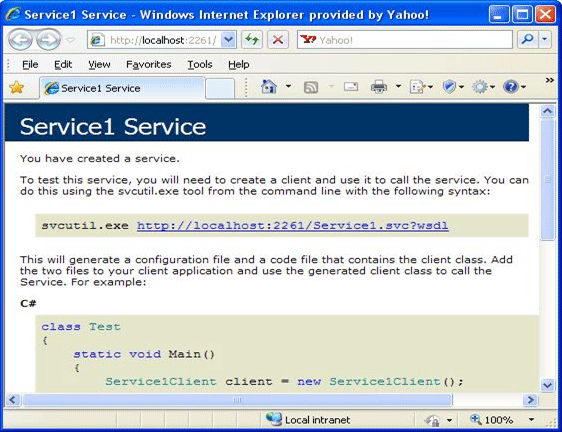
-
Publish the WCF Service.
-
9. How to Consume the WCF Service?
9.1
Generate the Class and Config File using svcutil.exe
You
might have noticed the message displayed while browsing the service

Now, we need to generate
the classes which our Client Application would use to consume the
service.
We may generate the classes/configuration with the help of
tool svcutil.exe. Follow the steps to generate the Class/Config file
-
Open the command prompt and Go to the location where
svcutil.exe is placed. You may find the same at following place
"C:\Program Files\Microsoft SDKs\Windows\v6.0A\bin"
-
Write the following command and hit the "enter key" to
generate the Class/Config files

-
-
The class generated and the config file we need to
include into our client application for consuming the service.
9.2 Create Client to Consume Service
-
Open Visual Studio
-
Go to File-> New -> Project
-
Select Windows Form Application
-
Create a Form similar to below
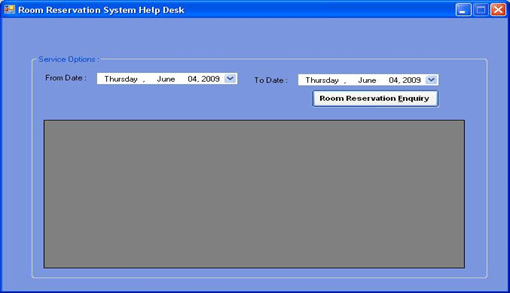
-
Include the class generated by Step iii of Section 8.1
-
Right Click on project and select the option "Add
Service Reference"
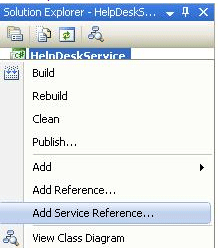
-
Enter the URL/ Address where service is hosted and hit
on "Go" button to find the service. You may see the Services
Methods/Logic exposed by WCF Service

-
Click "OK" to add the service.
-
Double Click Room Reservation Enquiry button to write
the logic. Make sure that you have imported the
private
void
btnEnquiry_Click(object
sender, EventArgs
e)
{
Service1Client
client = new
Service1Client
();
RoomReservationRequest
[]
reservationEnquiry = null
;
reservationEnquiry =
client.GetReservations(dateFromDate.Value, dateToDate.Value);
if
(reservationEnquiry.Length > 0)
{
gvReservationData.DataSource = reservationEnquiry;
gvReservationData.Visible = true
;
}
else
{
gvReservationData.Visible = false
;
lblMessage.Text = "Sorry data
not available."
;
}
}
-
When we had added the reference of the Service to the
client project one configuration file also would have been added to the
application i.e. App.Config. Replace the <system.serviceModel>
node of this file by the <system.serviceModel> node of the
output.config file generated into "Step- 3" of "Section 7.1"
-
Run the client application to. Enter From Date, To
Date and click Enquiry button to test the application.
10. How to Use the Source?
Unzip the file
WCF.zip, you may find the following files
-
DBBackup.zip
-
Source.zip
Restore/ Create Database
Unzip the file
DBBackup.zip and restore the WCF.bak file to SQL Server Database or you
may create the database as suggested in Step 8.1.
Now, Unzip the
file Source.zip, you may find
-
WCFService
-
WCFClient
Publish/Host Client
-
Open the directory WCFService.
-
Double click Practice.WCF.sln file to open the
solution.
-
Modify the web.config file of Service as suggested in
Step-7 of Section-8.2.
-
Publish the service as suggested in Step-16 of
Section-8.2.
Use WCF Client to consume the services
-
Open WCFClient directory.
-
Double click HelpDeskService.sln file to open the
solution.
-
Run the solution.
-
Select the dates and hit on Enquiry button.
Note:
You may need to modify App.Config file, if you have not published the
WCF Service to local machine.














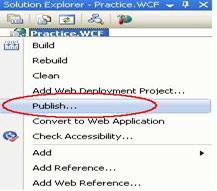
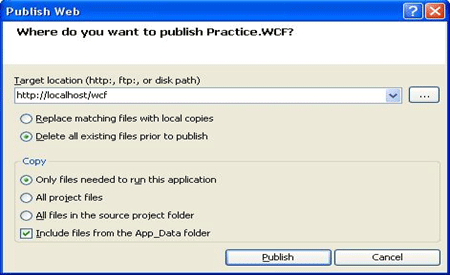








相关推荐
Inside Microsoft Windows Communication Foundation byJustin Smith Microsoft Press 2007 (304 pages) ISBN:9780735623064 Offering the deep architectural insights you need for building service-oriented...
WCF(Windows Communication Foundation)是微软推出的一种统一的编程模型和技术框架,用于构建跨平台的服务通信应用程序。它支持多种通信协议,并且能够与非WCF客户端进行交互。 **特点**: - **统一的平台**:WCF...
### Windows Communication Foundation (WCF) in .NET Framework 3.5 #### Introduction to WCF Windows Communication Foundation (WCF) is a comprehensive framework designed by Microsoft for building ...
It is a worthy successor to earlier versions and includes new features such as Language Integrated Query (LINQ), multi-targeting of environments, and better integration of Windows Communication ...
**Windows Communication Foundation (WCF) 知识点详解** Windows Communication Foundation(WCF)是微软.NET框架中的一个组件,用于构建可互操作的分布式应用程序。它整合了多种通信技术,如.NET Remoting、Web ...
- **工作流服务**:结合WCF(Windows Communication Foundation),WF可以构建基于XAML的工作流服务,实现服务间的交互和流程自动化。 6. **学习资源** - **Introduction-to-XAML-in-Windows-Workflow-Foundatio....
Chapter 35: Windows Communication Foundation 1252 What Is WCF ? 1253 WCF Concepts 1254 WCF Programming 1258 Summary 1282 Exercises 1283 Chapter 36: Windows Workflow Foundation 1284 ...
Mastering ServiceStack is targeted at developers who have already implemented web services with ASMX, WCF, or ServiceStack and want to gain more insight into the possibilities ServiceStack has to ...
- **Server-Side Technologies:** Technologies such as the Server Object Model and Windows Communication Foundation (WCF). - **Client-Side Technologies:** Technologies such as JavaScript, HTML, and CSS ...
WCF (Windows Communication Foundation) 是一种用于创建服务导向应用程序的技术,它提供了统一的编程模型来支持多种通信协议。为了让 Silverlight 应用能够与服务器端进行通信,我们需要添加一个 WCF 服务。 #### ...
.NET Framework 3.0是开发Silverlight应用的基础,它包含了Windows Communication Foundation (WCF)、Windows Workflow Foundation (WF)、Windows Presentation Foundation (WPF)和Windows CardSpace等组件。...
- WCF(Windows Communication Foundation):探讨服务导向架构,理解WCF服务的配置和使用。 6. **C#模块6(csharp-module6)** - 高级特性:如匿名方法、lambda表达式、表达式树、动态类型等。 - 装箱与拆箱:...
.NET Framework 3.5是微软的一个重要版本,包含了对WCF(Windows Communication Foundation)、WPF(Windows Presentation Foundation)和WF(Windows Workflow Foundation)的支持。这些技术使得开发人员能够构建更...
- **企业级应用**: Silverlight的.NET兼容性使其能与其他企业级开发工具和框架集成,如WCF(Windows Communication Foundation)和ASP.NET。 **3. 示例代码解析** `SilverlightIntroduction_src.zip` 文件可能...
- **附录C**:WCF简介(WCF Primer)——简要介绍了Windows Communication Foundation的基本概念和技术要点。 - **附录D**:资源(Resources)——列举了一些有用的参考资料和链接。 以上就是对《精通IIS7电子书...
Choosing to use IBM MQ classes for Java or IBM MQ classes for JMS.............................................. 45 Design techniques for messages..........................................................